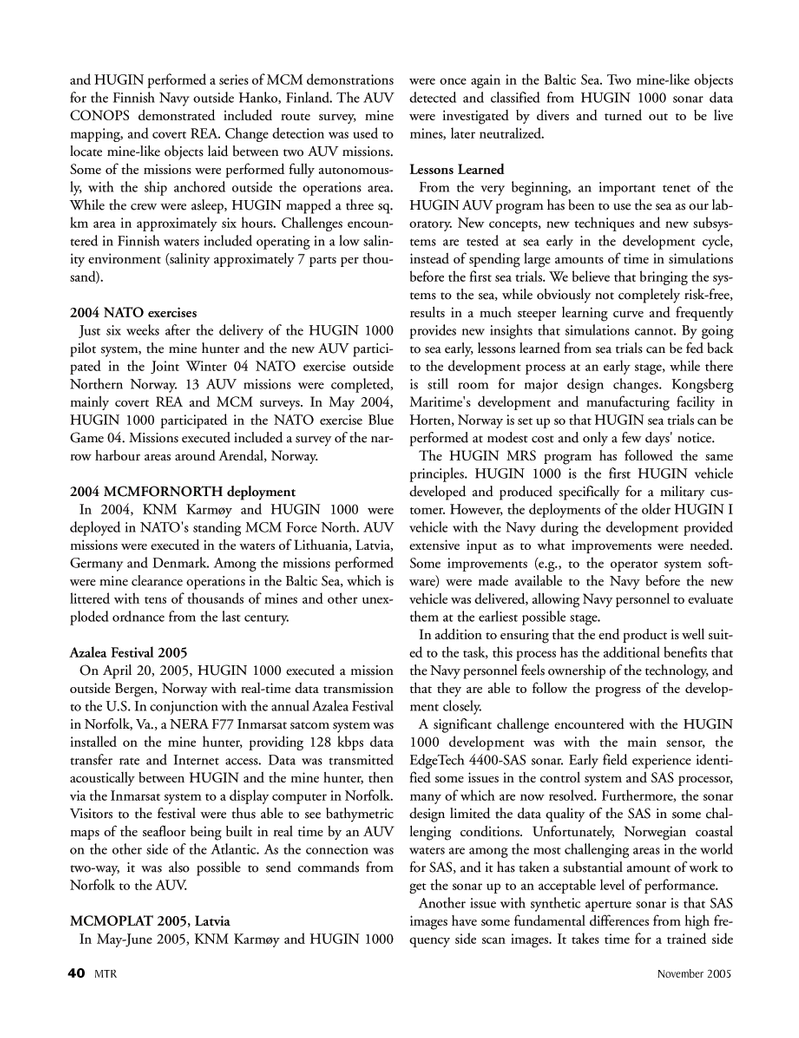
Page 40: of Marine Technology Magazine (November 2005)
Seafloor Engineering
Read this page in Pdf, Flash or Html5 edition of November 2005 Marine Technology Magazine
40 MTR November 2005 and HUGIN performed a series of MCM demonstrations for the Finnish Navy outside Hanko, Finland. The AUV
CONOPS demonstrated included route survey, mine mapping, and covert REA. Change detection was used to locate mine-like objects laid between two AUV missions.
Some of the missions were performed fully autonomous- ly, with the ship anchored outside the operations area.
While the crew were asleep, HUGIN mapped a three sq. km area in approximately six hours. Challenges encoun- tered in Finnish waters included operating in a low salin- ity environment (salinity approximately 7 parts per thou- sand). 2004 NATO exercises
Just six weeks after the delivery of the HUGIN 1000 pilot system, the mine hunter and the new AUV partici- pated in the Joint Winter 04 NATO exercise outside
Northern Norway. 13 AUV missions were completed, mainly covert REA and MCM surveys. In May 2004,
HUGIN 1000 participated in the NATO exercise Blue
Game 04. Missions executed included a survey of the nar- row harbour areas around Arendal, Norway. 2004 MCMFORNORTH deployment
In 2004, KNM Karmøy and HUGIN 1000 were deployed in NATO's standing MCM Force North. AUV missions were executed in the waters of Lithuania, Latvia,
Germany and Denmark. Among the missions performed were mine clearance operations in the Baltic Sea, which is littered with tens of thousands of mines and other unex- ploded ordnance from the last century.
Azalea Festival 2005
On April 20, 2005, HUGIN 1000 executed a mission outside Bergen, Norway with real-time data transmission to the U.S. In conjunction with the annual Azalea Festival in Norfolk, Va., a NERA F77 Inmarsat satcom system was installed on the mine hunter, providing 128 kbps data transfer rate and Internet access. Data was transmitted acoustically between HUGIN and the mine hunter, then via the Inmarsat system to a display computer in Norfolk.
Visitors to the festival were thus able to see bathymetric maps of the seafloor being built in real time by an AUV on the other side of the Atlantic. As the connection was two-way, it was also possible to send commands from
Norfolk to the AUV.
MCMOPLAT 2005, Latvia
In May-June 2005, KNM Karmøy and HUGIN 1000 were once again in the Baltic Sea. Two mine-like objects detected and classified from HUGIN 1000 sonar data were investigated by divers and turned out to be live mines, later neutralized.
Lessons Learned
From the very beginning, an important tenet of the
HUGIN AUV program has been to use the sea as our lab- oratory. New concepts, new techniques and new subsys- tems are tested at sea early in the development cycle, instead of spending large amounts of time in simulations before the first sea trials. We believe that bringing the sys- tems to the sea, while obviously not completely risk-free, results in a much steeper learning curve and frequently provides new insights that simulations cannot. By going to sea early, lessons learned from sea trials can be fed back to the development process at an early stage, while there is still room for major design changes. Kongsberg
Maritime's development and manufacturing facility in
Horten, Norway is set up so that HUGIN sea trials can be performed at modest cost and only a few days' notice.
The HUGIN MRS program has followed the same principles. HUGIN 1000 is the first HUGIN vehicle developed and produced specifically for a military cus- tomer. However, the deployments of the older HUGIN I vehicle with the Navy during the development provided extensive input as to what improvements were needed.
Some improvements (e.g., to the operator system soft- ware) were made available to the Navy before the new vehicle was delivered, allowing Navy personnel to evaluate them at the earliest possible stage.
In addition to ensuring that the end product is well suit- ed to the task, this process has the additional benefits that the Navy personnel feels ownership of the technology, and that they are able to follow the progress of the develop- ment closely.
A significant challenge encountered with the HUGIN 1000 development was with the main sensor, the
EdgeTech 4400-SAS sonar. Early field experience identi- fied some issues in the control system and SAS processor, many of which are now resolved. Furthermore, the sonar design limited the data quality of the SAS in some chal- lenging conditions. Unfortunately, Norwegian coastal waters are among the most challenging areas in the world for SAS, and it has taken a substantial amount of work to get the sonar up to an acceptable level of performance.
Another issue with synthetic aperture sonar is that SAS images have some fundamental differences from high fre- quency side scan images. It takes time for a trained side
MTR#3 (33-48).qxd 11/14/2005 1:27 PM Page 40

 39
39

 41
41
